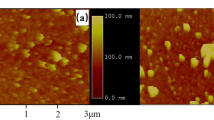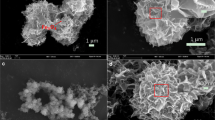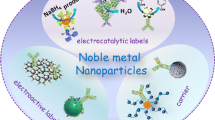Abstract
Traditional enzyme-linked immunosorbent assay (ELISA) with sufficient sensing specificity is a useful analytical approach for the detection of toxicologically important substances in in vivo systems or complicated biological systems. Increasing worldwide demand for analyses of bacteria by signal amplification and increasing concern regarding their safe development and use require a simple, stable, and sensitive detection assay for target evaluation and clinical diagnosis. A sensitive and selective immunoassay for detection of bacteria is constructed that combines horseradish peroxidase (HRP)-catalyzed signal amplification with the strong linker of the polydopamine–biotin complex on the surface of solid substances or biomolecules. The incorporation of HRP labeling and amplification increases the detection sensitivity by about one to two orders of magnitude compared with conventional ELISA systems. A linear relationship between the response and the logarithm of the bacterial concentration was observed in the range from 1.5 × 102 to 1.5 × 107 colony-forming units per milliliter. This work demonstrates a new signal-amplification-based dopamine-mediated process for the development of a sensitive method. This dopamine-mediated immunoassay may be broadly applied in clinical diagnoses and for the monitoring of water environmental pollution. The approach proposed is distinct with simple protocols and easy processes, which allow it to be applied in a broad area.



Similar content being viewed by others
References
Wan Y, Wang Y, Wu J, Zhang D. Graphene oxide sheet-mediated silver enhancement for application to electrochemical biosensors. Anal Chem. 2011;83(3):648–53.
Taton TA, Mirkin CA, Letsinger RL. Scanometric DNA array detection with nanoparticle probes. Science. 2000;289(5485):1757–60.
Möller R, Powell RD, Hainfeld JF, Fritzsche W. Enzymatic control of metal deposition as key step for a low-background electrical detection for DNA chips. Nano Lett. 2005;5(7):1475–82.
de la Rica R, Stevens MM. Plasmonic ELISA for the ultrasensitive detection of disease biomarkers with the naked eye. Nat Nanotechnol. 2012;7(12):821–4.
Clutter MR, Heffner GC, Krutzik PO, Sachen KL, Nolan GP. Tyramide signal amplification for analysis of kinase activity by intracellular flow cytometry. Cytom Part A. 2010;77A(11):1020–31.
Lee H, Dellatore SM, Miller WM, Messersmith PB. Mussel-inspired surface chemistry for multifunctional coatings. Science. 2007;318(5849):426–30.
Wan Y, Zhang D, Wang Y, Qi P, Hou B. Direct immobilisation of antibodies on a bioinspired architecture as a sensing platform. Biosens Bioelectron. 2011;26(5):2595–600.
Kang SM, Hwang NS, Yeom J, Park SY, Messersmith PB, Choi IS, et al. One-step multipurpose surface functionalization by adhesive catecholamine. Adv Funct Mater. 2012;22(14):2949–55.
Yang K, Lee JS, Kim J, Lee YB, Shin H, Um SH, et al. Polydopamine-mediated surface modification of scaffold materials for human neural stem cell engineering. Biomaterials. 2012;33(29):6952–64.
You I, Kang SM, Lee S, Cho YO, Kim JB, Lee SB, et al. Polydopamine microfluidic system toward a two-dimensional, gravity-driven mixing device. Angew Chem Int Ed. 2012;51(25):6126–30.
Kang SM, You I, Cho WK, Shon HK, Lee TG, Choi IS, et al. One-step modification of superhydrophobic surfaces by a mussel-inspired polymer coating. Angew Chem Int Ed. 2010;49(49):9401–4.
Ryu J, Ku SH, Lee H, Park CB. Mussel-inspired polydopamine coating as a universal route to hydroxyapatite crystallization. Adv Funct Mater. 2010;20(13):2132–9.
Waite JH. Surface chemistry - mussel power. Nat Mater. 2008;7(1):8–9.
Ling D, Park W, Park YI, Lee N, Li F, Song C, et al. Multiple-interaction ligands inspired by mussel adhesive protein: synthesis of highly stable and biocompatible nanoparticles. Angew Chem Int Ed. 2011;50(48):11360–5.
Na HB, Palui G, Rosenberg JT, Ji X, Grant SC, Mattoussi H. Multidentate catechol-based polyethylene glycol oligomers provide enhanced stability and biocompatibility to iron oxide nanoparticles. ACS Nano. 2012;6(1):389–99.
Gillich T, Benetti EM, Rakhmatullina E, Konradi R, Li W, Zhang A, et al. Self-assembly of focal point oligo-catechol ethylene glycol dendrons on titanium oxide surfaces: adsorption kinetics, surface characterization, and nonfouling properties. J Am Chem Soc. 2011;133(28):10940–50.
Medintz IL, Stewart MH, Trammell SA, Susumu K, Delehanty JB, Mei BC, et al. Quantum-dot/dopamine bioconjugates function as redox coupled assemblies for in vitro and intracellular pH sensing. Nat Mater. 2010;9(8):676–84.
Yah WO, Xu H, Soejima H, Ma W, Lvov Y, Takahara A. Biomimetic dopamine derivative for selective polymer modification of halloysite nanotube lumen. J Am Chem Soc. 2012;134(29):12134–7.
Gu H, Yang Z, Gao J, Chang CK, Xu B. Heterodimers of nanoparticles: formation at a liquid-liquid interface and particle-specific surface modification by functional molecules. J Am Chem Soc. 2004;127(1):34–5.
Lequin RM. Enzyme immunoassay (EIA)/enzyme-linked immunosorbent assay (ELISA). Clin Chem. 2005;51(12):2415–8.
Van Weemen BK, Schuurs AHWM. Immunoassay using antigen-enzyme conjugates. FEBS Lett. 1971;15(3):232–6.
Yalow RS, Berson SA. Immunoassay of endogenous plasma insulin in man. J Clin Investig. 1960;39(7):1157–75.
Dixit CK, Vashist SK, MacCraith BD, O'Kennedy R. Multisubstrate-compatible ELISA procedures for rapid and high-sensitivity immunoassays. Nat Protoc. 2011;6(4):439–45.
Bobrow MN, Harris TD, Shaughnessy KJ, Litt GJ. Catalyzed reporter deposition, a novel method of signal amplification application to immunoassays. J Immunol Methods. 1989;125(1–2):279–85.
Rissin DM, Kan CW, Campbell TG, Howes SC, Fournier DR, Song L, et al. Single-molecule enzyme-linked immunosorbent assay detects serum proteins at subfemtomolar concentrations. Nat Biotechnol. 2010;28(6):595–9.
Acknowledgements
We gratefully acknowledge support from the Research Foundation of Hainan University (KYQD(ZR)1711) and the National Natural Science Foundation of China (grant no. 41076047).
Author information
Authors and Affiliations
Corresponding author
Ethics declarations
Conflict of interest
The authors declare that they have no competing financial interests.
Electronic supplementary material
ESM 1
(PDF 94 kb)
Rights and permissions
About this article
Cite this article
Wan, Y., Zhu, G. Dopamine-mediated immunoassay for bacteria detection. Anal Bioanal Chem 409, 6091–6096 (2017). https://doi.org/10.1007/s00216-017-0545-x
Received:
Revised:
Accepted:
Published:
Issue Date:
DOI: https://doi.org/10.1007/s00216-017-0545-x




